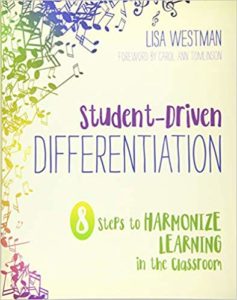Eight Steps to Student Driven Differentiation
Student-Driven Differentiation: 8 Steps to Harmonize Learning in the Classroom
By Lisa Westman
(Corwin/SAGE Publications, 2018 – Learn more)
 Reviewed by Julie Battikha
Reviewed by Julie Battikha
If you’ve ever taught any grade level, subject, or student population, you will likely have run into this overwhelming question: “How do I meet all of my students’ academic, emotional, and mental needs during the school day while getting through the content and staying on schedule for the year?”
The word differentiation might pop up as the apparent solution, but you still might be unsure of exactly what it entails or how to do it effectively.
 Even though I went to graduate school for special education and work with a small population of learning disabled students, I still struggle with the “D” word on a constant basis. There is so much to process as I get to know new students each year, learn about up and coming differentiation strategies, and consider the opinions and policies of fellow teachers and administrators in my school.
Even though I went to graduate school for special education and work with a small population of learning disabled students, I still struggle with the “D” word on a constant basis. There is so much to process as I get to know new students each year, learn about up and coming differentiation strategies, and consider the opinions and policies of fellow teachers and administrators in my school.
A phenomenal PD resource
If you have ever felt like me, then I must introduce you to Lisa Westman’s phenomenal PD resource that breaks down exactly how and why we need to differentiate with our students in mind. In her book, Student-Driven Differentiation: 8 Steps to Harmonize Learning in the Classroom, Westman takes you through why we need differentiation in the first place, and the process of working tested differentiation strategies into your teaching. Best of all, she provides further support and motivation for implementing these practices in your classroom and school.
The section that I felt I grew the most from was the first one on the foundation of why we differentiate. Here, Westman notes that before you put a lower level worksheet in front of a kid, or allow them to choose a different display style for their history project, you need to take the time to get to know the student as a person.
A lot can be learned about a student by quietly paying attention; for example, just listening to a conversation they are having as they walk into your classroom. The insights you gather can actually help you meet their academic needs once you know how to apply what you have learned.
Westman further breaks down the importance of using student data not just for number crunching and grades, but to help inform what the student needs next in order to ultimately succeed.
Practical strategies to bring differentiation to class
In Westman’s section on areas of learning to differentiate, she gives many practical strategies outlined in resource boxes throughout the pages. One such resource that I know I will definitely use in my classroom is called “9 Ways to Get Students Up and Moving.” This chart lists nine kinesthetic, yet collaborative thinking, activities that help students learn and process the content.
Throughout the book, Westman includes many vignettes from teachers around the country who have grown in one or more of the topics included. These are especially helpful as they allow the reader to see how another professional applied a differentiation component in their own teaching.
These accounts particularly helped me to understand Westman’s section on beginning to actually plan out the differentiation tactics in my teaching. She offers specific tips on defining the learning goals for the lesson, hooking students at the beginning to make the lesson relevant, incorporating formative assessment, working with students to set goals, and providing the most effective feedback before the final assignment is complete.
Building student ownership
Before Westman closes out her guide to student differentiation, she delves into techniques that are meant to grow the ownership of each student in their own differentiated, unique learning paths.
Technology is one of the main resources and supports in today’s education, and Westman expertly describes how to use that to your advantage. Among the other valuable resources in Westman’s book are reproducible checklists, a self-reflection guide at the end of each chapter, and discussion questions for professional development among multiple staff.
Student choice is another strong anchor for guiding students to owning their educational goals. This gets tricky in my classroom since I always feel the need to make sure each kid understands the choices given to them, and I often end up holding on too tightly to the reins. But Westman explains that when we provide students with multiple options over time, they will learn to try them out until they find what best suits them.
Just as students will gradually learn what tools they need to succeed in their education, we teachers can do the same with goal-setting and incorporating choice of our own to ultimately reach self-efficacy. I know I won’t grow into a master of differentiation in a week, or even just in this next school year. But I’m excited to take away as many nuggets as I can from Lisa Westman’s valuable resource and apply them one by one so that I can continuously grow in my ability to create conditions in which students can best learn.
Julie Battikha is a 6th grade special education teacher in Hillsborough, New Jersey. She has been teaching for three years and mostly works with students in the inclusion classroom for science and social studies. She is proud to have graduated with a Master’s from Rutgers Graduate School of Education and is excited to continue learning and growing in the areas of co-teaching and differentiation in her area of education.
































